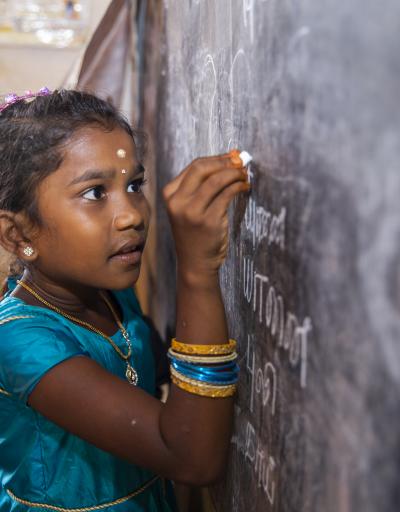
Article
Q&A: How are African countries improving the quality of their education?

Many countries in Africa are taking important and significant steps as they strive to achieve their education goals, and some have made impressive progress is certain areas. However, much remains to be done as sub-Saharan Africa is still home to the world’s largest out-of-school population. One in five primary school-age children and well over half of upper secondary school-age adolescents are not attending school. In about half of African countries, the out-of-school rate among primary school-age children is less than 10% while it is over 50% for the upper secondary school. This rate is increasing in several countries.
The continental report Education in Africa : Placing equity at the heart of policy, jointly conducted by UNESCO and the African Union, is the first in what will become a regular stocktaking of education in Africa. It analyses progress made towards achieving the goals sets out in Continental Education Strategy for Africa 2016-2025 and Sustainable Development Goal 4 , and also outlines ongoing efforts and remaining challenges in the sector.
What is the situation for access to quality education in Africa?
In about half of African countries, the out-of-school rate among primary school-age children is less than 10% while it is over 50% for the upper secondary school. This rate is increasing in several countries. Approximately 80% of children in sub-Saharan Africa are still not being taught in a language they speak at home, which significantly hampers learning outcomes.
This continental report highlights wide disparities between countries in Africa in terms of access to education for the majority. African governments need to place a greater emphasis on equity in their policy planning and budget considerations. But even this may not be enough.
In the long term, providing an equitable access to quality education, particularly for disadvantaged children, can have a positive effect by reducing social, economic, and gender inequalities and building a peaceful society.
Why place equity at the heart of education policy in Africa?
Placing equity at the heart of quality education for all in Africa is a way to build a better and prosperous future for the continent’s children. Improving the chances of all children to access quality education requires a complex set of interventions by governments, and implementing reforms of only some of the building blocks is not enough.
Equity means giving all children equal access to safe, quality, and relevant education. It is about ensuring that learners’ personal and social circumstances are not obstacles to achieving their educational potential. Achieving equitable access to quality education is impacted by a large and varied range of factors, some of which are beyond the control of governments.
An educated population provides a country with a more skilled workforce that participates more actively and meaningfully in economic and social development, and therefore contribute positively to society at large. Young, educated citizens are key to breaking the intergenerational cycle of poverty. However, sub-Saharan Africa has the world’s largest out-of-school population while the informal sector is responsible of 86% of all jobs. As it was mentioned at the Transforming Education Summit, education today is in crisis in regard to equity and inclusion, quality, and relevance.
Why should gender be integrated into equitable education policies?
In sub-Saharan African countries, the enrolment gap between girls and boys widens as they progress through school. The possibility of attending school and completing the education cycle is far more complicated generally for girls. In all regions, more girls are out of school at secondary level than boys.
Indeed, gender is linked to disparities in enrolment, retention, completion, and learning outcomes through multiple mechanisms including social conditioning, gender-based differences in parental expectations and education-related investments, child marriages and early childbearing, child labour, gender-based violence, and discrimination.
Gender inequalities in society, including the labour market, and education are, to a large extent, mutually causal. As a result, progress towards gender parity in education can help reduce gender inequalities in society and work, and vice versa. When gender-related factors intersect with other disadvantages, such as poverty, remote location, and disability, their negative effects on education can be aggravated. Progress towards gender parity in education helps to reduce gender inequalities in society and in the world of work.
How has the COVID-19 pandemic affected education systems in Africa?
The pandemic has led to unprecedented disruption of education services in Africa, and the effects on educational attainment, learning outcomes and disparities in education are not yet known and measured. It highlighted the disproportionately negative impact that school closures have on disadvantaged children, which is likely to widen disparities in enrolment, completion, and learning. Indeed, it has taken a toll on both young children’s development through increased risks to their and their families’ well-being, and the decreased availability of early childhood care and education and other early childhood development services due to service disruptions and school closures.
In fact, the pandemic has magnified existing disparities and aggravated system-level weaknesses, by causing dropouts and school closures, and breaking the educational continuity for millions of children. The pandemic has made it even harder for governments to fulfil the education commitments. It has highlighted the fragility of education systems and therefore the need to build resilience at the school and system level.
As a result, ongoing efforts to enhance the education system now face the additional task of preparing for future crises and potential disruptions. More specifically, this includes work around ICT-related investments in school facilities, teacher training in digital skills and remote learning, and curriculum revisions to accommodate remote learning. In this regards, digital innovation has demonstrated its powers to complement, enrich and transform education. Access to public digital learning is one of the key priorities of UNESCO and was one of the main calls to action at the Transforming Education Summit in September 2022.
What are the key findings of the report?
The analysis underlines important trends that are summarized in the following five key messages:
- Pan-African efforts facilitating mutual learning across countries deserve more attention and investment, especially more opportunities to share their experiences.
- Planning and progress rely on a twofold challenge: improving the availability and quality of data and promoting strategies for its continuous use in decision making and implementation.
- Equity needs to be at the heart of policy planning and investment decisions at all levels of education.
- Timely and accurate information on the state of education provision is crucial to formulating ambitious yet realistic strategic plans.
- African governments need to both invest in system-level components to build resilience into the foundations of their education systems and sustain the capabilities and motivations of key stakeholders (particularly teachers) so that they are willing and able to adapt to future challenges.
This joint publication by UNESCO and the African Union builds on a study conducted by UNESCO’s International Institute for Educational Planning to review the advances made by African countries to reach the goals set out in the Continental Education Strategy for Africa 2016-2025 and SDG.
- Read the report
- Access the executive summaries








